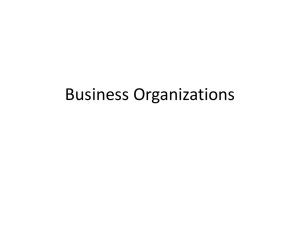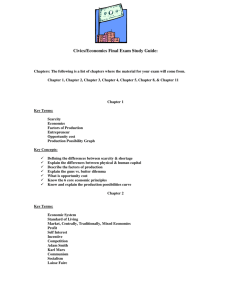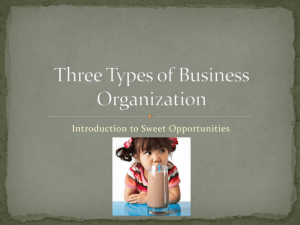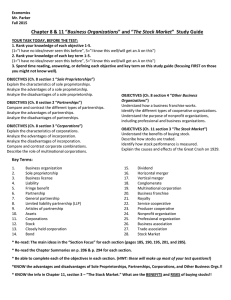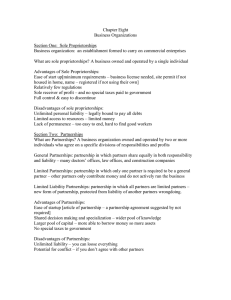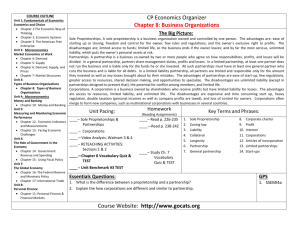Economic Decision Makers
advertisement
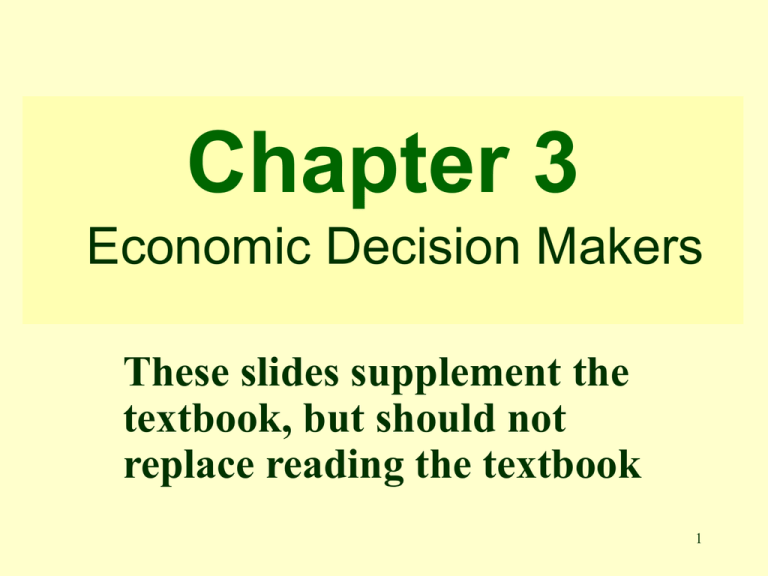
Chapter 3 Economic Decision Makers These slides supplement the textbook, but should not replace reading the textbook 1 Who makes decisions in the economy ? Households Businesses Governments Foreigners 2 How has the typical household changed? More women are in the workforce The two income family is more common 3 Why are more women in the workforce? Inflation of the 1970’s Higher education levels Higher wages Increase in the divorce rate Change in attitudes Higher taxes 4 Sources of U.S. Personal Income 13% Transfer payments 8% 8% 5% 2% 64% Proprietors' income Dividends Rental income Wages and salaries Personal interest 5 What are transfer payments? Cash or in-kind benefits given to individuals as outright grants from the government 6 On what do households spend their money? Durable goods Nondurable goods Services 7 Why does household production still exist? No skills or specialized resources are required Household production avoids taxes Household production reduces transaction costs Advances in technology 8 What are the three ways entrepreneurs organize firms? Sole proprietorships Partnerships Corporations 9 What is a sole proprietorship? A firm with a single owner who has the right to all profits and who bears unlimited liability for the firm’s debts 10 What is a partnership? A firm with multiple owners who share the firm’s profits and each of whom bears unlimited liability for the firm’s debts 11 What is a corporation? A legal entity owned by stockholders whose liability is limited to the value of their stock 12 What are the three types of corporations? C Chapter S Limited Liability 13 Percentage of firms by type Corporations 20% Partnerships 7% Percentage of sales by type Corporations 88% Sole Proprietorships 73% Partnerships 7% Sole Proprietorships 5% 14 What is market failure? A condition that arises when unrestrained operation of markets yields socially undesirable results 15 What is the role of government? The government ... 16 Establishes & enforces rules of the game Promotes competition Regulates natural monopolies Provides public goods Deals with externalities Promotes a more equal distribution of income Strives for full employment, price stability, and economic growth 17 How does the government establish and enforce rules of the game? It safeguards private property and enforces contracts 18 How does the government promote competition? Antitrust laws try to promote competition by prohibiting collusion and other anticompetitive practices 19 What is a monopoly? The sole producer of a product for which there are no good substitutes 20 What is a natural monopoly? One firm that can serve the entire market at a lower per-unit cost than can two or more firms 21 What is the downside for a natural monopoly? It is regulated by the government 22 What is a public good? A good that is available for all to consume, regardless of who pays and who does not 23 How does the government provide for public goods? Taxes 24 Government spending as percent of GDP Government Spending in U.S. Since 1929 as Percentage of GDP 50 45 Total 40 35 30 25 State & local 20 15 10 Federal 5 0 1930 ’40 ’50 ’60 ’70 ’80 ’90 25 What is an externality? A cost or a benefit that falls on third parties and is therefore ignored by the two parties to the market transaction 26 How does the government deal with externalities? It employs taxes, subsidies, and regulations to discourage negative externalities and to encourage positive externalities 27 How does the government promote a more equal distribution of income? Transfer payments 28 How does the government promote full employment, price stability, & growth? By using monetary and fiscal policies 29 What is a fiscal policy? The use of government to influence aggregate economic activity through taxing and spending 30 What is a monetary policy? Regulation of the money supply in order to influence aggregate economic activity 31 What is a federal system of government? Responsibilities are shared across levels of government 32 Percentage Composition of Federal Receipts Since 1970 (share of total) Percent of total 100 80 60 All other Corporate taxes Payroll taxes 40 20 Individual income taxes 0 1970 ’75 ’80 ’85 ’90 ’95 ’00 33 What is tax incidence? The distribution of tax burden among tax payers 34 What is the ability to pay principle of taxation? Those with a greater ability to pay should pay more tax 35 What is the benefits received principle of taxation? Those who receive more benefits from government programs funded by a tax should pay more tax 36 What is proportional taxation? The tax as a percentage of income remains constant as income increases; also called a flat rate tax 37 What is progressive taxation? The tax as a percentage of income increases as income increases 38 What is marginal tax rate? The percentage of each additional dollar of income that goes to taxes 39 What is a regressive tax? The tax as a percentage of income decreases as income increases 40 Why does international trade occur? The opportunity cost of producing specific goods differs among countries 41 What is merchandise trade balance? The value of a country’s exported goods minus the value of its imported goods during a given time period 42 What is foreign exchange? The currency of another country needed to carry out international transactions £ 43 What is balance of payments? A record of all economic transactions between residents of one country and residents of the rest of the world during a given time period 44 What forms do restrictions on trade take? Tariffs Quotas Other restrictions, such as agreements among manufacturers 45 What is a tariff? A tax on imports or exports 46 What is a quota? A legal limit on the quantity of a particular product that can be imported or exported 47 Why do countries restrict trade? 48 To benefit domestic producers who lobby for protective legislation national defense protect infant industries foster diversification protect jobs 49 END 50
